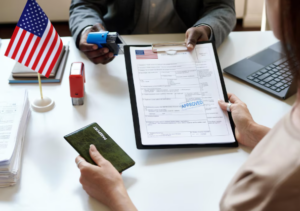Top Mistakes to Avoid on K-1 Fiancé Visa Forms

Top 8 Mistakes to Avoid on the Fiancé Visa Forms
When you’re applying for a K-1 visa, the emotion behind it is real. You’re not just filing government paperwork — you’re trying to bring someone you love across the world so you can start a life together in the U.S. We understand that. At Passage Immigration Law, we’ve helped hundreds of couples through this exact process. And we’ve also seen the kinds of mistakes that can delay or derail that process.
Today, we want to walk you through the most common mistakes people make on fiancé visa forms — not to scare you, but to help you avoid the stress, confusion, and heartbreak that can come with getting it wrong.
-
Rushing Through the K-1 Visa Forms
It’s easy to underestimate the complexity of the fiancé visa process. A lot of couples tell us, “We met in person, we’re in love, and we’re planning to get married. That should be enough, right?”
The truth is — it’s not.
Every section of the Form I-129F must be completed with accurate and consistent information. If your fiancé’s name is spelled one way on their passport and another on your petition, that’s a red flag. If you forget a prior address or an old employer, USCIS might pause your case.
The K-1 visa process step by step requires you to slow down, double-check every field, and understand what’s being asked. Rushing can lead to missing or incorrect information — and that often results in long delays.
-
Weak or Disorganized Proof of Relationship
One of the most important elements of a K-1 fiancé visa process is proving that your relationship is real. USCIS officers are trained to spot fraud, and they look closely at how couples present their relationships.
So, what counts as strong proof of a relationship for a K1 visa?
- Photos from multiple visits, not just one selfie
- Travel itineraries showing you’ve met in person within the last two years
- Screenshots of messages or call logs
- Statements from family and friends who know about the relationship
- A personal letter explaining how you met, fell in love, and decided to marry
What doesn’t help? Just writing “We love each other” without backing it up.
The K-1 visa evidence of relationship section should feel like a story. We help couples organize their documents so USCIS can see the timeline and the emotional journey.
-
Not Knowing What Happens After Filing
Filing the fiancé visa forms is only the beginning. Many couples get confused about what to do after marriage on a K1 visa or how to proceed once their partner arrives in the U.S.
Here’s a simplified breakdown:
- You file Form I-129F (the actual K-1 visa petition)
- USCIS processes your case
- You file forms DS-160 and I-134 with the Department of State
- Your fiancé attends a visa interview in their country
- If approved, they enter the U.S.
- You must marry within 90 days of your arrival
- After marriage, you file for adjustment of status (green card process)
The Adjustment of Status after the marriage phase is just as important as the initial petition. We’ve seen cases fall apart because couples weren’t sure what paperwork came next.
-
Missing Documents or Outdated Forms

Another surprisingly common mistake? Submitting the wrong documents — or using an outdated version of a form. Every few months, USCIS updates its forms, and if you’re not using the current version, your application can be rejected.
Double-check the following:
- You’re submitting the latest Form I-129F
- You’ve included all required documents for a fiancé visa
- Your passport-style photos meet USCIS requirements
- You include the correct filing fee ($675 for Form I-129F, at the time of writing)
Missing even one of these details can trigger a rejection or a Request for Evidence (RFE) — and that can set your timeline back by months.
-
Not Meeting the Financial Sponsorship Requirements
When sponsoring your fiancé to the U.S., you must prove you can support them financially. This means submitting recent tax returns, pay stubs, and a Declaration of Financial Support during the K-1 phase (Form I-134). You then later need to submit an Affidavit of Support (Form I-864) during the adjustment of status phase.
This is one of the K1 visa requirements for petitioners — and skipping it or underestimating its importance is a mistake.
If you’re self-employed or your income is close to the required minimum, we recommend getting legal guidance before submitting your petition.
-
Confusion Around the Timeline

One of the most common questions we get is: “How long does the fiancé visa process take?”
The truth is that processing times vary. On average:
- USCIS may take 7 to 9 months to process Form I-129F
- The consulate interview may take another 2–3 months
- After your fiancé enters the U.S., you must marry within 90 days
- Then, the green card process can take another 8–14 months
We often advise couples to prepare for a 12–18 month K1 visa journey from start to finish. This is why it’s crucial to get the paperwork right the first time — because small errors create long delays.
-
Not Understanding What the Government Is Looking For
Let’s be honest — the process of the K1 visa isn’t always intuitive. It’s not just about proving you’re in love. It’s about fitting your relationship into a system designed to prevent fraud.
USCIS wants to know:
- Did you meet in person within the last two years?
- Do you intend to marry within 90 days of entry?
- Are you both legally free to marry?
- Are you financially capable of supporting your fiancé?
Understanding how the fiancé visa process works — from a government perspective — helps you present your case in the best light.
-
Not Getting Legal Help When You Need It
We get it — hiring an attorney sounds like an extra expense. But the cost of a fiancé visa in the U.S. isn’t just the filing fee. It’s the emotional cost of being apart longer than necessary. It’s the financial cost of re-filing if you make a mistake.
Working with our team at Passage Immigration Law means you don’t have to guess. We’ll help you gather the right documents, avoid common errors, and move through the process with clarity and confidence.
Final Thoughts: A Mistake-Free Start to Your Marriage
The fiancé visa step-by-step process isn’t designed to be romantic. It’s designed to protect borders and prevent fraud. But that doesn’t mean you can’t approach it with care, clarity, and confidence.
Avoiding these common mistakes gives your application the best possible chance of success — and gives you and your fiancé the chance to start your life together without unnecessary delays.
If you want help filing — or just want someone to look over what you’ve prepared — we’re here.
Get Expert Help From Passage Immigration Law

At Passage Immigration Law, we believe love deserves a fair chance, without paperwork getting in the way. We’ve helped hundreds of couples navigate the complex K1 fiancé visa process, from the first form to the final green card.
Let’s help you avoid common mistakes and file with confidence.
Contact us today to schedule your consultation. Your future together starts now.
Disclaimer: This article offers general legal information, not legal advice. Do not rely upon this information without seeking legal counsel. If you need legal advice, you may contact us directly to speak with an attorney. We disclaim all liability with respect to actions taken based on any information presented. Every case is different, and outcomes will vary depending on the unique facts and legal issues of your case.
